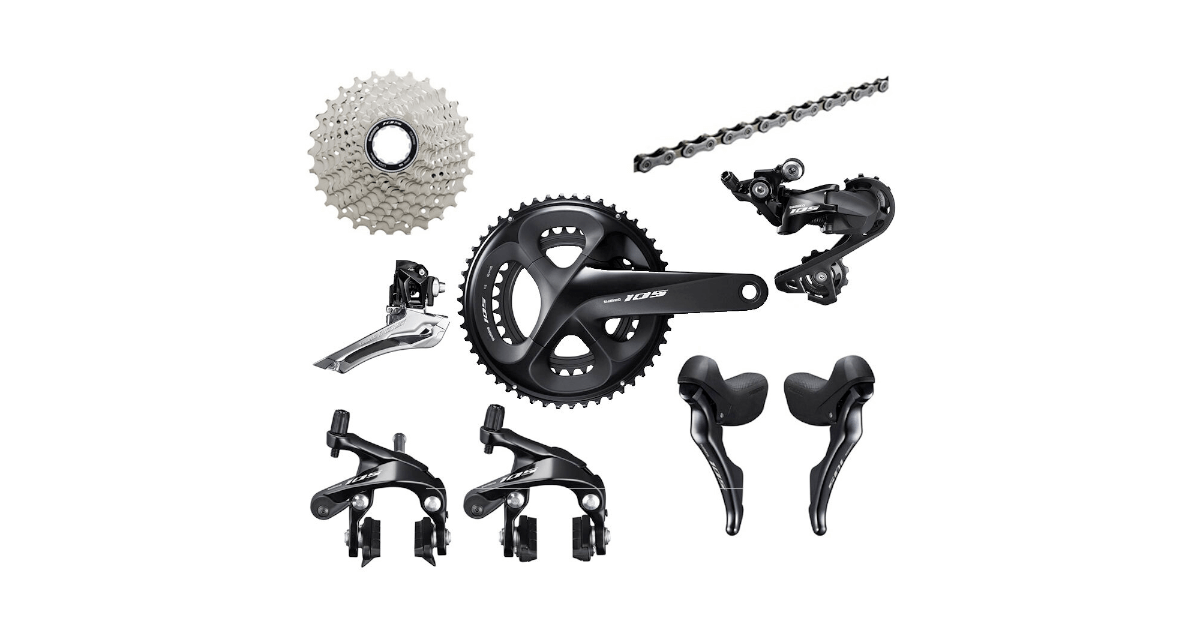Overview and Specifications of WheelTop's Affordable Electronic Groupset "EDS"
This article summarizes the features and specifications of the budget-friendly electronic groupset "EDS" newly released by the Chinese manufacturer WheelTop.
Posted at: Jan 28, 2021
When you're looking to ride a better road bike, the question often arises—should you upgrade your components or buy a new bike altogether? This article compares both options to help you decide which is more cost-effective.

Table of contents
Sponsored Link
At first glance, buying a brand-new road bike — typically priced at over ¥100,000 — might seem less cost-effective compared to upgrading individual parts. However, when you break down the cost of each component, complete bikes often turn out to offer excellent value.
If you want to upgrade components like the groupset, you’ll usually need to replace the entire set (except for minor cases below Shimano 105), which drives up the cost. If you don’t handle the installation yourself and rely on a bike shop, you’ll also need to pay for labor, bringing the total cost closer and closer to the price of a new bike.
For example, a new Shimano 105 (R7000 series) groupset typically costs over $500. Once you add labor costs, the total often comes to around $800. On the other hand, a brand-new complete bike equipped with 105 from a budget-friendly manufacturer can cost just over $1,000 — meaning you only need to pay $200 more for a full new bike.
Of course, this depends on which part(s) you’re upgrading, so it’s essential to get a sense of the cost range for each individual component.

Road Bike Component Prices by Parts
When upgrading your road bike, you may be wondering which parts to upgrade from. In this article, we will compare the prices of different parts based on the list price of Shimano's components for road bikes.
On many new bikes, the components (like drivetrain and brakes) account for 40–50% of the price. That means the rest of the cost effectively covers the frame, tires, wheels, and other high-priced items — giving you a set of quality spare parts at a reasonable price.
Especially if you only own one road bike, a new complete bike can serve as a smart investment: you can treat everything except the frame as backup parts. Having extra consumables like tires and wheels on hand adds peace of mind.
If you don’t have space at home for a second fully assembled bike, you can disassemble parts like the wheels, handlebars, and pedals to store it in a compact 80%-assembled form — which fits easily into a closet or other small storage space.
Sponsored Link
When it comes to Shimano component tiers, road bikes equipped with 105 or higher usually come with high-quality frames and wheels. This makes upgrading to even better components quite expensive.
In such cases, rather than buying a new high-end complete bike, upgrading select parts is often more cost-effective and delivers better performance for less money.
Especially since all Shimano components from 105 and up are 11-speed and compatible with each other, you don’t need to upgrade everything at once. You can upgrade individual parts — such as just the STI levers or crankset — allowing you to experiment and gradually improve your setup.
If you can source parts affordably and assemble the road bike yourself, a custom build can be significantly cheaper than buying a new complete bike.
For example, even if you keep your current frame and upgrade all the other components, you can build a bike that matches or undercuts the price of a new one — and you get the satisfaction of using all the components you really want.
Complete bikes often cut costs by including lower-end parts for expensive components like wheels, cranks, or brakes. If you’re particular about your setup, a custom build is likely the best option.
So which is more cost-effective — buying a new bike or upgrading your current one?
The answer depends on what you want to upgrade, how you plan to do it, and your available budget.
Take the time to think through the parts you truly want to improve, and choose the more economical path that fits your goals.
Sponsored Link
Shimano Road Bike Components: Brand, Grade, and Identification
A summary of Shimano's road bike component brands, grades and how to identify them. The model numbers and features of each are also included.
Shimano Road Bike Component Compatibility Summary
Compatibility of Shimano Components for Road Bikesa Shimano components for road bikes tend to be confusing with various parts in different grades and generations. In this article, we summarize the compatibility trends of Shimano components.
Road Bike Component Prices by Parts
When upgrading your road bike, you may be wondering which parts to upgrade from. In this article, we will compare the prices of different parts based on the list price of Shimano's components for road bikes.
Advantages and Disadvantages of Road Bike Component Sets
A road bike component set, where you can get all the necessary component parts at once and get a discount. The following is a summary of the advantages and disadvantages of component sets and points to keep in mind when purchasing them.
Road Bike Gear Shifting Speeds: Pros and Cons of Upgrading
The higher the grade of road bike components, the more gear shifts are available. In this article, we will look at the advantages and disadvantages of upgrading to a higher grade of component and increasing the number of gear shifts.
When would you upgrade the drivetrain on a road bike?
Surprisingly, it is difficult to know when is the best time to upgrade the drivetrain on a road bike. In this issue, we take a look at when to upgrade.
PCD compatibility chart for cranks and chainrings
We have compiled a PCD compatibility chart to use as a guide when replacing the chainring on your crank.
Overview and Specifications of WheelTop's Affordable Electronic Groupset "EDS"
This article summarizes the features and specifications of the budget-friendly electronic groupset "EDS" newly released by the Chinese manufacturer WheelTop.
What Is Shimano Shadow RD? Features and Benefits
What is Shimano’s Shadow RD used in their latest rear derailleurs? This article explains its features and the benefits of choosing Shadow RD.
[MTB / Hybrid Bike] Hydraulic Brake Manufacturers for Flat Bars
An overview of manufacturers that produce hydraulic brakes for flat-bar MTB and hybrid bikes, along with their key features. Also includes tips on how to choose the right flat-bar hydraulic brake brand.
Shimano Chain Compatibility for Road, MTB, and Hybrid Bikes
An overview of Shimano chain compatibility across road bikes, mountain bikes, and hybrid bikes. Includes guidance on how to choose the right chain for your drivetrain.
Shimano ESSA Lineup and Compatibility with Existing 8-Speed Parts
An overview of Shimano's newly released 8-speed component group "ESSA" and its compatibility with existing 8-speed parts.
SRAM Cassette Compatibility Guide
Compatibility guide for SRAM cassettes used in road and MTB bikes. Find matching drivetrains and wheels easily.
Compatibility Guide for SRAM MTB Components
A detailed explanation of compatibility between SRAM MTB components. This guide outlines which parts can be used together and which combinations are not compatible.
Road and MTB Sprockets Compatibility Overview
A guide to the compatibility between road and MTB sprockets, explaining whether they can be used together with different components.
Types of Shimano Di2 Tools and Their Compatibility
A guide to the essential Shimano Di2-specific tools, especially the "plug tools" used for connecting components, and their compatibility with various Di2 parts.
Shimano CUES Cassette Compatibility Guide
A detailed guide to the compatibility of Shimano CUES series cassettes. Includes an overview of compatible rear derailleurs, chains, and wheels.
Shimano Hydraulic Brake Hose and Connector Standards Guide
An explanation of the differences between Shimano’s hydraulic brake hoses BH90 and BH59, the types of connecting bolts, and how to choose the right hose for your brake system—including key points to watch out for.
[By Manufacturer] Types, Features, Pros and Cons of Hydraulic Brake Oils
This article explains the types of hydraulic oils used in bicycle hydraulic brakes, their characteristics, and the brake oil types used by each manufacturer.
Types and Compatibility of Shimano Di2 Batteries
The Di2 battery is the core of the Shimano Di2 system, influencing the overall system layout. This article explains the different types and their compatibility.
Shimano Di2 Wire Types and Compatibility
Overview of Shimano Di2 electric wire types and their compatibility with Di2 components.
How to Identify Shimano Di2 Generations
Explains the generational differences in Shimano Di2 components and their compatibility. Includes a list of component series and their corresponding generations.
In-Depth Guide to Shimano 12-Speed Cassette Compatibility
A detailed explanation of the key compatibility factors when using Shimano's 12-speed cassettes—specifically the required wheel (freehub) and drivetrain, which differ significantly from previous 11-speed systems.
Perfect Guide to Shimano 11-Speed Cassette Compatibility
A detailed explanation of two key compatibility factors when using Shimano 11-speed cassettes: the required wheel (freehub) and drivetrain.
Perfect Guide to Shimano 10-Speed Cassette Compatibility
A detailed explanation of two key compatibility factors when using Shimano 10-speed cassettes: the required wheel (freehub) and drivetrain.
In-Depth Guide to Shimano 9-Speed Cassette Compatibility
A comprehensive explanation of two key compatibility factors when using Shimano 9-speed cassettes: the required wheel (freehub) and drivetrain.
What Is a BOOST Crank? Differences from Standard MTB Cranks and How to Choose
This article explains what a BOOST crank is, how it differs from conventional MTB cranks, and provides guidance on selection across different manufacturers.